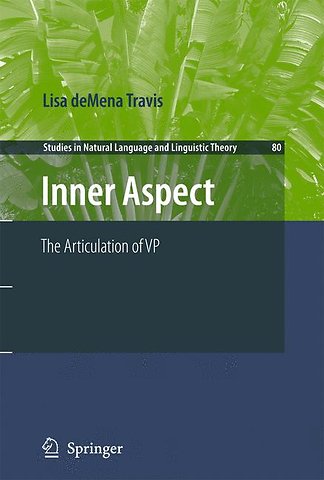Inner Aspect
The Articulation of VP
Paperback Engels 2012 2010e druk 9789400732162Samenvatting
Finishing this book was one of the most difficult things I have ever done. It took far too long from original idea to page proofs and suffered from being relegated to small corners of my life. It was very rarely on the front burner. Since I started working on this topic in 1991, there has been a lot of interesting work done on the areas of the articulation of VP, phrase structure mirroring event structure, the use of functional categories to represent Aktionsart, and many other areas that the research presented here touches on. The hardest thing about doing a project of this size is to accept that not everyone’s ideas can be addressed and not all new research can be incorporated. The only way that I have found it possible to let this book go to press is to reread the Preface to Events in the Semantics of English by Terence Parsons where he writes, ‘‘The goal of this book is neither completeness nor complete accuracy; it is to get some interesting proposals into the public arena for others to criticize, develop, and build on. ’’ My aim in this book is to make connections between various accounts of various constructions in various languages at the risk of treating each of these too lightly. I am grateful to too many people to thank them individually.
Specificaties
Lezersrecensies
Inhoudsopgave
Inner Derived Objects. 2.1 Introduction.2.2 Background. 2.3 Early Proposals. 2.4 Two Object Positions. 2.5 Objects Within the VP. 2.6 Conclusion.-
Inner Aspect and Event. 3.1 Introduction. 3.2 Arguing for Inner Aspect. 3.3 Arguing for the Existence of Event. 3.4 Partial A-Movement. 3.5 Conclusion.-
Event Structure and Phrase Structure. 4.1 Introduction. 4.2 Preparing the Ground. 4.3 Semantics in the Syntax. 4.4 The Syntax of Event Structure. 4.5 Language Variation. 4.6 Conclusion.-
Interaction of Objects and Aspect. 5.1 The Interaction of Case and Aspect. 5.2 The Position of Incremental Themes. 5.3 Conclusion.-
L-Syntax and S-Syntax. 6.1 Background. 6.2 Causatives. 6.3. Empty Anaphors in Tagalog. 6.4 Where and What is L-Syntax? 6.5 L-Syntax and the Lexicon. 6.6 Summary. 6.7 Discontinuous Lexical Items. 6.8 The Lexicon and Lexical Categories. 6.9 Conclusion.-
The Syntax of Achievements.7.1 Introduction. 7.2 The Semantic Problem. 7.3 The Shape of Achievements.7.4External Arguments and LCS.7.5 Conclusion.-
Bounds and Coercion. 8.1 Introduction. 8.2 Endpoints. 8.3 Null Telic Morphemes and Lexical Entries. 8.4 Coercion and Selection. 8.5 Viewpoint vs. Situation Aspect. 8.6 Conclusion.-
Conclusion. 9.1 Introduction. 9.2 Lexical vs Functional. 9.3 Lexical Entries and Idioms. 9.4 Theta Roles and Aspectual Roles. 9.5 The Nature of Coercion. 9.6 Further Questions.-
References
Rubrieken
- advisering
- algemeen management
- coaching en trainen
- communicatie en media
- economie
- financieel management
- inkoop en logistiek
- internet en social media
- it-management / ict
- juridisch
- leiderschap
- marketing
- mens en maatschappij
- non-profit
- ondernemen
- organisatiekunde
- personal finance
- personeelsmanagement
- persoonlijke effectiviteit
- projectmanagement
- psychologie
- reclame en verkoop
- strategisch management
- verandermanagement
- werk en loopbaan

